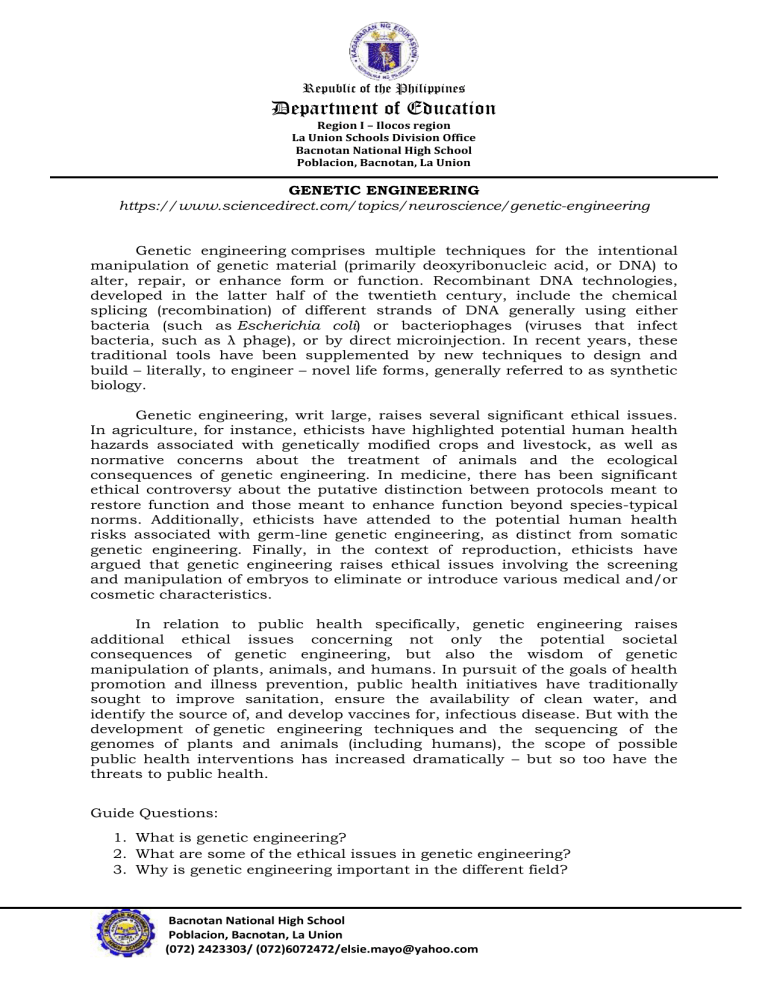
Republic of the Philippines Department of Education Region I – Ilocos region La Union Schools Division Office Bacnotan National High School Poblacion, Bacnotan, La Union GENETIC ENGINEERING https://www.sciencedirect.com/topics/neuroscience/genetic-engineering Genetic engineering comprises multiple techniques for the intentional manipulation of genetic material (primarily deoxyribonucleic acid, or DNA) to alter, repair, or enhance form or function. Recombinant DNA technologies, developed in the latter half of the twentieth century, include the chemical splicing (recombination) of different strands of DNA generally using either bacteria (such as Escherichia coli) or bacteriophages (viruses that infect bacteria, such as λ phage), or by direct microinjection. In recent years, these traditional tools have been supplemented by new techniques to design and build – literally, to engineer – novel life forms, generally referred to as synthetic biology. Genetic engineering, writ large, raises several significant ethical issues. In agriculture, for instance, ethicists have highlighted potential human health hazards associated with genetically modified crops and livestock, as well as normative concerns about the treatment of animals and the ecological consequences of genetic engineering. In medicine, there has been significant ethical controversy about the putative distinction between protocols meant to restore function and those meant to enhance function beyond species-typical norms. Additionally, ethicists have attended to the potential human health risks associated with germ-line genetic engineering, as distinct from somatic genetic engineering. Finally, in the context of reproduction, ethicists have argued that genetic engineering raises ethical issues involving the screening and manipulation of embryos to eliminate or introduce various medical and/or cosmetic characteristics. In relation to public health specifically, genetic engineering raises additional ethical issues concerning not only the potential societal consequences of genetic engineering, but also the wisdom of genetic manipulation of plants, animals, and humans. In pursuit of the goals of health promotion and illness prevention, public health initiatives have traditionally sought to improve sanitation, ensure the availability of clean water, and identify the source of, and develop vaccines for, infectious disease. But with the development of genetic engineering techniques and the sequencing of the genomes of plants and animals (including humans), the scope of possible public health interventions has increased dramatically – but so too have the threats to public health. Guide Questions: 1. What is genetic engineering? 2. What are some of the ethical issues in genetic engineering? 3. Why is genetic engineering important in the different field? Bacnotan National High School Poblacion, Bacnotan, La Union (072) 2423303/ (072)6072472/elsie.mayo@yahoo.com Republic of the Philippines Department of Education Region I – Ilocos region La Union Schools Division Office Bacnotan National High School Poblacion, Bacnotan, La Union RECOMBINANT DNA TECHNOLOGY https://byjus.com/biology/recombinant-dna-technology/ A technique mainly used to change the phenotype of an organism (host) when a genetically altered vector is introduced and integrated into the genome of the organism. So, basically, this process involves the introduction of a foreign piece of DNA structure into the genome which contains our gene of interest. This gene which is introduced is the recombinant gene and the technique is called the recombinant DNA technology. The technology used for producing artificial DNA through the combination of different genetic materials (DNA) from different sources is referred to as Recombinant DNA Technology. Recombinant DNA technology is popularly known as genetic engineering. The recombinant DNA technology emerged with the discovery of restriction enzymes in the year 1968 by Swiss microbiologist Werner Arber, Inserting the desired gene into the genome of the host is not as easy as it sounds. It involves the selection of the desired gene for administration into the host followed by a selection of the perfect vector with which the gene must be integrated and recombinant DNA formed. Thus, the recombinant DNA must be introduced into the host. And at last, it must be maintained in the host and carried forward to the offspring. Guide Questions: 1. What is recombinant DNA technology? 2. Why is recombinant DNA technology beneficial? 3. How is recombinant DNA technology used in producing artificial DNA? Bacnotan National High School Poblacion, Bacnotan, La Union (072) 2423303/ (072)6072472/elsie.mayo@yahoo.com Republic of the Philippines Department of Education Region I – Ilocos region La Union Schools Division Office Bacnotan National High School Poblacion, Bacnotan, La Union A HISTORY OF LIFE ON EARTH https://study.com/academy/lesson/the-history-of-life-on-earth Humans have only been a species in the most recent chapter of the history of Earth. The Earth was formed 4.6 billion years ago, when the sun in our solar system first formed, creating enough gravitational pull to spin planets into orbit. But how do scientists know how old the Earth is if humans weren't around back when it was formed? When was life first formed on this planet? And what are the paths that life has taken so far over the course of that existence? This lesson will teach about the ages that make up the history of life on Earth and explore the many changes and forms life has taken in its time on this planet. The geological timeline of Earth is nearly identical to the history of life on Earth, apart from the Hadean Eon. This is because the geological timeline, or the order of geological events, such as oceans forming, volcanoes erupting, how long deserts lasted, and tectonic plate movement, all happened in sequence with the life that has existed on this planet. The history of both life and the geological timeline is arranged within 5 subgroups, arranged from the largest span of time to the smallest: eons, eras, periods, epochs, and ages. To understand the timeline of life that has existed on Earth, it is important to understand how scientists determine the age of both rocks and the remnants of living things, otherwise known as fossils. Because humans were not around 4.6 billion years ago to record the beginnings of our planet, scientists must rely on evidence from geological and fossil records in order to determine the relative age of both the planet and the life that exists here. Both the geological timeline and the age of life are determined in much the same way. Modern scientists rely on what is called radioactive dating to determine an accurate and precise age of both rocks and fossils. Guide Questions: 1. What is geologic timescale? 2. What are the divisions of the geologic timescale? 3. How do scientists know how old the Earth is if humans weren't around back when it was formed? Bacnotan National High School Poblacion, Bacnotan, La Union (072) 2423303/ (072)6072472/elsie.mayo@yahoo.com




